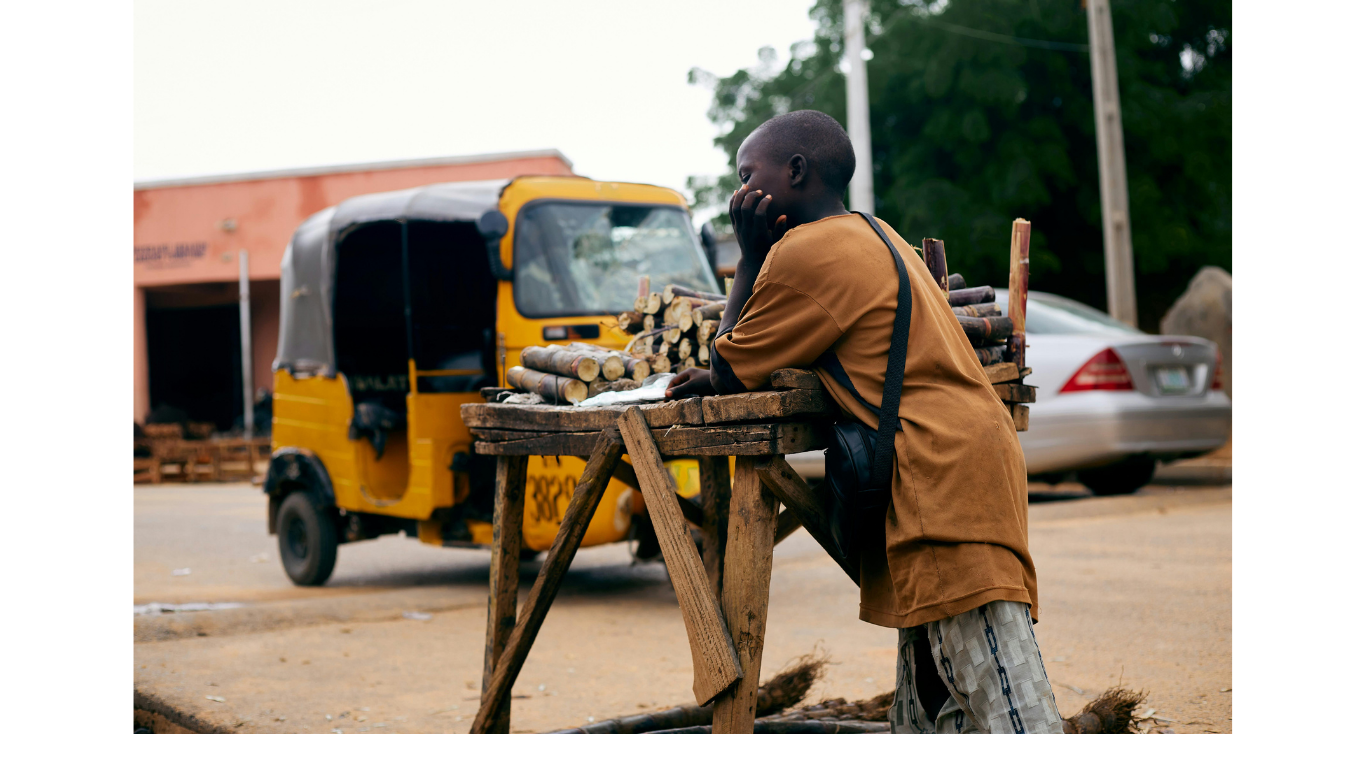AGOA's Sunset: What the End of U.S. Preferential Trade Means for Africa's Industrial Future
Street vendor selling sugarcane in urban Africa
When the African Growth and Opportunity Act expired on September 30, 2025, it didn't just close a chapter in U.S.-Africa trade relations—it exposed the fragility of an economic relationship built on dependency rather than partnership. For over two decades, AGOA offered duty-free access to U.S. markets for roughly 35 sub-Saharan African countries, a preferential arrangement that Washington framed as development assistance and African governments accepted as opportunity. Now, as that arrangement ends, Africa faces a critical question: Will it scramble to restore American preferences, or will it finally build the industrial sovereignty it should have been constructing all along?
The answer to that question will determine whether Africa enters the next decade as a mature economic actor or remains trapped in the extractive relationships that have defined its global position since colonization.
What AGOA Achieved—and What It Carefully Avoided
Let's be clear about what AGOA was: a conditional trade preference program that allowed certain African exports to enter the United States duty-free, provided those countries met Washington's political and economic criteria. At its peak in the early 2010s, AGOA-eligible imports reached approximately $60 billion annually. By recent years, that figure had collapsed to between $10 and $13 billion—a decline that tells its own story about the program's structural limitations.
AGOA did create jobs. In Lesotho, Kenya, Ethiopia, and Madagascar, the apparel sector expanded significantly, employing tens of thousands of workers, predominantly women. South Africa leveraged AGOA to strengthen its automotive exports. These are real gains that supported real livelihoods, and dismissing them would be both callous and analytically dishonest.
But AGOA was never designed to transform African economies. It was designed to integrate them into American supply chains on American terms.
The program concentrated African exports in low-skill, low-value sectors—primarily textiles and apparel—while doing little to encourage the kind of industrial upgrading that would allow African countries to compete without preferential access. Rules of origin requirements often forced African manufacturers to source inputs from the U.S. or other approved countries rather than building regional supply chains. The entire structure reinforced dependency: African countries got market access, but not the tools to build independent industrial capacity.
Ethiopia's experience crystallizes AGOA's political nature. After years of successfully building a garment export sector under AGOA, Ethiopia was suspended from the program in 2021 following the Tigray conflict—a decision that had little to do with trade policy and everything to do with Washington's geopolitical preferences. Thousands of Ethiopian workers, mostly women, lost their jobs not because their government failed economically, but because it failed politically in American eyes. This is what conditional development looks like: access granted, access revoked, always at the discretion of the benefactor.
Economic Exposure: Counting the Cost
The immediate impact of AGOA's expiration will be felt most acutely in countries that structured significant portions of their export economies around the program. Kenya, Lesotho, Madagascar, Ghana, and South Africa face potential tariff increases of 15 to 30 percent on their apparel exports to the United States. For countries where the garment sector represents a meaningful share of formal employment and export earnings, this is not an abstraction—it's a jobs crisis waiting to happen.
Lesotho is particularly vulnerable. Its textile and apparel sector, which employed over 40,000 workers at its height, was almost entirely AGOA-dependent. Without duty-free access, Lesotho's exports become immediately uncompetitive against Asian and Latin American producers who benefit from other preferential arrangements or lower labor costs. Women workers—who make up the majority of garment employees—will bear the brunt of factory closures and production cuts.
Kenya has been more strategic, using AGOA access to build a more diversified export base including horticulture and manufactured goods, but even Kenya's apparel sector faces serious disruption. Madagascar's export processing zones, which attracted significant investment on the basis of AGOA access, now confront an uncertain future. Ghana's emerging textiles industry, still in its infancy, loses a key competitive advantage before it can fully develop.
South Africa's automotive sector is better positioned—its exports are more sophisticated and less easily replaceable—but even Pretoria must now calculate whether maintaining production for the U.S. market makes sense without preferential terms.
The human cost here is significant and gendered. Garment work, for all its exploitation and poor conditions, provided women in these countries with formal sector employment and some degree of economic autonomy. AGOA's end threatens to push many of these women back into informal work or unemployment, reversing modest but real gains in women's economic participation.
Competing Visions: Who Fills the Vacuum?
AGOA's expiration doesn't happen in a vacuum. Multiple actors are already positioning themselves to shape Africa's post-AGOA trade landscape, each with their own strategic interests.
China has been steadily relocating manufacturing capacity to Africa as part of its Belt and Road repositioning. Rising labor costs in China and trade tensions with the West have made Africa increasingly attractive for Chinese firms looking to maintain access to Western markets through African production bases. This isn't altruism—it's strategic industrial policy—but it does offer African countries an alternative source of manufacturing investment and technology transfer, provided they negotiate effectively.
The European Union continues to push Economic Partnership Agreements that would lock African countries into asymmetric trade relationships similar to AGOA but more permanent and potentially more constraining. Brussels frames these as mutually beneficial partnerships; African civil society organizations rightly see them as neocolonial arrangements that would undermine Africa's ability to protect infant industries and build regional value chains.
The African Continental Free Trade Area (AfCFTA) represents Africa's most important alternative—a framework for building intra-African trade that could reduce dependency on external markets and create the regional integration necessary for industrial development. AfCFTA's success depends on infrastructure investment, harmonized regulations, and political will to prioritize continental integration over bilateral deals with former colonial powers. It's the difference between Africa trading with itself on its own terms and Africa remaining fragmented and dependent on external preferences.
Gulf actors—particularly the UAE and Saudi Arabia—are increasing their investment in African processing industries, especially in agriculture and logistics. These relationships come with their own complications, including concerns about land rights and labor conditions, but they represent another potential source of capital and market access beyond the traditional Western-dominated framework.
The scramble is on. The question is whether African governments will use this moment to build collective bargaining power or whether they'll compete against each other for scraps from competing external partners.
The Geopolitical Scramble: Leverage or Dependency?
In Washington, there's already discussion of a "Post-AGOA Compact" and potential reauthorization in 2026. Some U.S. policymakers, concerned about China's growing influence in Africa, are floating the idea of AGOA 2.0—perhaps with different conditions, different beneficiaries, different terms. African governments will face pressure to lobby for inclusion in whatever emerges.
But here's the critical strategic question: Should Africa be lobbying for renewed American preferences, or should it be using this moment to fundamentally restructure its trade relationships around sovereignty and reciprocity rather than charity and conditionality?
The geopolitical context matters. The United States is increasingly viewing Africa through a great power competition lens, not a development lens. Any renewed trade preference will likely come with enhanced political conditionality—expectations around voting patterns at the UN, positions on China and Russia, domestic governance reforms that align with American preferences. This isn't speculation; it's already been demonstrated through Ethiopia's suspension and similar actions.
Meanwhile, China, the EU, and Gulf states are all offering their own versions of economic partnership, each with strategic strings attached. The multiplication of options doesn't necessarily mean more leverage—it can mean more pressure, more conditionality, more opportunities for African governments to be played against each other.
The alternative is collective action through institutions like the African Union and AfCFTA—using post-AGOA transition as an opportunity to build African-centered trade frameworks that prioritize regional integration, industrial upgrading, and strategic autonomy. This is harder. It requires African governments to trust each other, to resist the temptation of bilateral deals that benefit individual countries at the expense of continental coherence, and to invest in the infrastructure and institutions that regional integration demands.
Strategic Pathways: Beyond Dependency
If Africa is serious about industrial transformation—and it should be—AGOA's end must be treated not as a crisis to be managed but as an opportunity to be seized. That requires several strategic shifts:
First, re-center structural transformation. Trade policy must serve industrial policy, not the other way around. That means protecting infant industries, building regional supply chains, investing in skills development and technology transfer, and creating the conditions for African firms to move up the value chain. It means accepting that short-term efficiency losses from protecting domestic industries may be necessary for long-term industrial capacity building.
Second, build south-south bargaining leverage. African countries are stronger negotiating collectively than individually. The African Union should coordinate a unified position on post-AGOA arrangements, both with the United States and with other potential partners. BRICS+ offers another platform for advancing alternative frameworks to Western-dominated trade rules. The point isn't to replace one dependency with another, but to use multiple partnerships strategically to expand African policy space.
Third, invest in AfCFTA implementation. The African Continental Free Trade Area is meaningless without the infrastructure, regulatory harmonization, and political commitment to make it work. That means:
Regional "AGOA Transition Plans" that help vulnerable sectors and workers adjust while building alternatives through intra-African trade.
Investment in AfCFTA's product certification and logistics systems so that African goods can move across borders as easily as they currently move to Europe and America.
Financing mechanisms that support industrial upgrading and regional value chain development, including partnerships with African diaspora capital and African institutional investors.
Fourth, leverage diaspora capital and expertise. The African diaspora—including Black Americans—represents a massive pool of capital, expertise, and political influence that Africa has barely begun to tap strategically. Diaspora bonds, investment funds focused on African manufacturing, and policy advocacy networks that connect African and diaspora interests could all play roles in building post-AGOA alternatives.
The End of Dependence, Not the End of Trade
AGOA's expiration is only a crisis if Africa continues to view trade through the lens of dependence—as something granted by powerful partners rather than something negotiated between equals. The real crisis isn't the loss of preferential access to American markets; it's the fact that after 25 years of AGOA, African countries are still vulnerable to the loss of that access because they haven't built the industrial capacity to compete without it.
The history of development is clear: No region has industrialized by relying on the charity of already-industrialized powers. East Asia didn't develop through preferential trade access—it developed through strategic industrial policy, technology acquisition, and deliberate upgrading over time. Africa can learn from that history, or it can continue to hope that the next preferential arrangement will somehow deliver the transformation that previous ones didn't.
This moment demands clarity about what Africa wants to become. A continent of exporters grateful for market access on terms set elsewhere? Or a continent of producers capable of setting its own terms, building its own industries, and trading on the basis of mutual benefit rather than conditional generosity?
AGOA is over. The question now is what Africa builds in its place—and whether it has the political will and strategic coherence to build something that serves African interests rather than simply fitting Africa into someone else's supply chain.
The sunset of AGOA could be the dawn of African industrial sovereignty. But only if Africa chooses to make it so.

